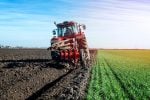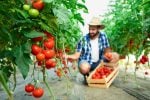Farming is not just about growing different types of food crops and plant life grown in diverse environments. In 2025, agriculture sits at the crossroads of business strategy, climate response, and technological advancement. The crops we choose to grow now, which are excellent sources of food, shape food security, business profits, and our planet’s future.
Did you know that just crop species provide 90% of the world’s food energy intake? Yet there are over 50,000 edible plant species on Earth, many of which are classified as food crops. This gap represents both risk and opportunity for agricultural businesses focused on human consumption. The Food and Agriculture Organization (FAO) highlights this issue as a major challenge for food security and biodiversity.
The world of crop selection and crop production has changed dramatically. What worked in 2020 may fail in 2025’s climate and market conditions. New resilient varieties, such as sorghum, are replacing traditional options. Consumer preferences are shifting toward sustainability. Technology is transforming which crops can grow where.
For business owners in agriculture, understanding these changes isn’t optional—it’s essential for survival.
This guide will walk you through:
Which crop categories offer the best business potential in today’s market
How sustainable practices are creating new profit opportunities
Which high-value crops can transform your bottom line
How technology is changing the game for yield management
Strategies to protect your business through smart diversification
The agricultural landscape of 2025 rewards those who understand not just what to grow, but why it matters. Let’s explore the crop types that could define your business success this year.
Metrobi drivers are rated 4.97/5
Trusted by local businesses for:
- Background-checked professionals
- Specialized in business deliveries
- Same drivers for consistency
- 4.97/5 average delivery rating
Understanding Core Types of Crops Based on 2025
Five main crop production categories form the backbone of global agriculture: grains, legumes, fruits, vegetables, and tubers.
Each type of crop serves specific roles in food security, economics, and sustainability.
Selecting the right crops requires balancing market demand, climate suitability, and resource availability.
Overview of Staple Food Crop Production: Grains, Legumes, Fruits, Vegetables, and Tubers
Agriculture in 2025 continues to revolve around five fundamental crop categories that feed the world’s growing population. These core types of crops form the foundation of global food systems and agricultural businesses.
Grains remain the world’s most widely grown crops, accounting for nearly 45% of global agricultural land use. Cereals such as cereals like wheat, rice, corn, barley, and oats provide essential carbohydrates that supply about 48% of human caloric intake worldwide. In the United States, corn dominates with projected plantings of 95.3 million acres for 2025, up 5.2% from 2024, according to USDA data. Despite this expansion, corn production faces profitability challenges and diseases, with government estimates suggesting corn would lose approximately $125 per acre based on current market conditions.
Legumes, including soybeans, chickpeas, lentils, and beans, as well as fiber crops, serve dual purposes in agricultural systems. They provide protein-rich foods and naturally fix nitrogen in soil, reducing fertilizer needs. Soybean acreage in the US is forecast at 83.5 million acres for 2025, down 4.1% from the previous year. While both corn and soybeans face profitability challenges, “soybeans would bring slightly less agony than corn” with projected losses of $95 per acre compared to corn’s $125 per acre.
Fruits and vegetables constitute high-value food crops as well as field crops that are essential for good health, balanced nutrition, and diversified farming operations. Fruits like apples, bananas, and citrus are significant cash crops with expanding global markets. Similarly, vegetables ranging from leafy greens to root crops represent intensive farming opportunities with higher per-acre returns than grain crops. The global fruit and vegetable market reached $2.23 trillion in 2024 and continues to grow as health-conscious consumers increase consumption.
Tubers and root crops, led by potatoes, cassava, and sweet potatoes, serve as important food security crops. They provide high caloric yields per acre and store well without sophisticated infrastructure. In 2025, tuber crops, including various roots, are gaining importance in climate resilience strategies due to their adaptability to variable growing conditions.
Emerging Specialty Types of Crops
Beyond traditional staples, specialty crops are carving larger niches in 2025’s agricultural landscape. Hemp, quinoa, and ancient grains like spelt and kamut have transitioned from niche to mainstream in many markets. Medicinal and aromatic plants, along with industrial crops, serve dual purposes for both the pharmaceutical and culinary industries.
Superfoods like moringa, açaí, and sea buckthorn represent high-value opportunities for farmers looking to diversify. The global superfoods market is projected to reach $272 billion by 2028, growing at 7.4% annually.
Role and Importance of Each Different Type of Crop Rotation in Global Agriculture
Each crop category, from grains to fruits, plays distinct roles in the global agricultural ecosystem, contributing differently to agricultural productivity, food security, economic development, and environmental sustainability, as well as illustrating various types of crops.
Grain crops serve as the primary foundation of global food security. They provide the bulk of calories consumed worldwide and form the basis of animal feed systems that support livestock consumption, meat, and dairy production. In economic terms, grain markets drive much of agricultural finance, with futures markets determining prices that affect millions of farmers. The international grain trade exceeded $175 billion in 2024, highlighting its central role in global food systems. Beyond direct consumption, grains supply raw materials for processed foods, beverages, and industrial products, including biofuels and bioplastics.
Legumes perform critical dual functions in agricultural systems. As food crops, they provide essential protein, fiber, and micronutrients, serving as affordable protein sources in many regions. From an agronomic perspective, their nitrogen-fixing capabilities make them valuable rotation crops that enhance soil health.
Fruit and vegetable crops deliver essential micronutrients and dietary diversity critical for addressing global nutrition challenges. These crops generate significantly higher economic returns per acre than grains, creating opportunities for small and medium-sized farms to achieve profitability on limited land. They also drive rural employment due to their labor-intensive nature, with fruit and vegetable production typically requiring 5-7 times more labor hours than mechanized grain farming.
Tuber crops provide food security advantages in challenging environments. They offer exceptional caloric yield efficiency—potatoes produce more food per unit of water than any other major crop. Their underground growth protects them from many extreme weather events, making them increasingly important in climate adaptation strategies. In developing regions, tubers often serve as fallback crops when other harvests fail.
Key Considerations for Choosing Industrial Crop Types for Business
Selecting appropriate crops for an agricultural business requires balancing multiple factors, including market conditions, production capabilities, and risk management strategies associated with livestock.
Market demand and pricing trends should drive initial crop selection decisions. Current data shows premium pricing for organic grains (20-50% above conventional), specialty varieties of common crops, and locally-grown fresh produce for direct marketing. Contract opportunities with processors, retailers, or institutional buyers, including for kharif crops, can provide price stability but require meeting specific quality standards and delivery schedules. Export markets offer expanded sales potential for high-quality crops but introduce additional compliance requirements and currency risks.
Production capabilities, including climate suitability, water availability, and soil characteristics, create the fundamental constraints within which crop selection must operate. Temperature and precipitation patterns in your region determine suitable crop species and varieties, with climate change expanding some opportunities while limiting others. Water resources—both quantity and quality—increasingly define crop selection, with per-acre water requirements varying dramatically across crop types. Soil fertility factors significantly impact crop performance, as highlighted by research showing “a 50-plus bushel per acre yield difference in cornfields with boron,” demonstrating how micronutrient management can dramatically affect staple crop productivity.
Capital requirements vary substantially across crop types, creating important business constraints. Grain production generally requires significant equipment investment but lower per-acre operating costs. Fruit and vegetable production often involves higher operating costs but may require less initial equipment investment, particularly for small-scale operations. Establishment costs for perennial crops like tree fruits or nuts necessitate multi-year financial planning. Processing, storage, and distribution needs for oils also vary by crop, affecting total capital requirements.
Risk assessment must consider both production and market risks. Diversification across crop types and livestock with different risk profiles, including the use of atmospheric nitrogen, provides the most effective protection against both weather and market volatility. Insurance availability and cost significantly affect risk management strategies for different crops, with traditional program crops enjoying better coverage options than specialty crops. Market concentration risks increase when dependent on single crops or limited marketing channels.
Sustainable Agriculture Practices: What You Should Know
Sustainable agriculture combines profitability with environmental stewardship, offering 20-30% higher profit margins than conventional methods.
Regenerative practices like cover cropping and no-till farming reduce input costs while improving soil health.
The sustainable agriculture market is growing at 11.2% annually, reaching $16.75 billion in 2025
The Economic Value of Sustainable Farming Systems with Forage Crops, Annual Plants, etc.
Sustainable agriculture represents a fundamental shift from conventional farming towards more responsible agricultural production. Sustainable agriculture focuses on methods that maintain productivity through high-quality seeds while protecting natural resources for future generations and ensuring economic stability. Recent data shows farmers using regenerative practices report 20-30% higher profit margins compared to conventional methods. This comes from both premium pricing and reduced input costs.
The market size backs up this growth trend. The sustainable agriculture sector has grown from $15.07 billion in 2024 to $16.75 billion in 2025, a compound annual growth rate (CAGR) of 11.2%. Projections show this market reaching $23.95 billion by 2029. These numbers tell a clear story: sustainable farming is not just an environmental choice but a smart business decision for developing countries.
For farmers asking “which agricultural crop is most profitable?” the answer increasingly includes sustainable options. Crops grown with organic or regenerative practices often command premium prices while costing less to produce. Hemp, once overlooked, now offers profit margins of $200-400 per acre when grown sustainably. Similarly, specialty grains like ancient wheats (einkorn, emmer, spelt) fetch 2-3 times the price of conventional wheat when grown using sustainable methods.
Comparing Profit Potential: Conventional vs. Sustainable
When examining profit potential across different farming systems, several key factors stand out. First, sustainable farms typically have lower input costs for synthetic fertilizers and pesticides. A five-year study from the Rodale Institute found organic systems used 45% less energy and were more profitable than conventional systems.
Second, price premiums for sustainably-grown products create significant revenue advantages. Organic produce consistently commands 20-100% higher prices than conventional equivalents. Even non-certified but sustainably grown crops often receive 10-30% premiums in direct market channels.
Third, sustainable systems show greater resilience to extreme weather events, reducing the financial risks associated with crop failures. During drought years, organic corn yields are 31% higher than conventional corn, according to long-term farming systems trials involving rabi crops.
Core Sustainable Practices Driving Profitability
Understanding which sustainable practices deliver the greatest economic returns is essential for business planning. Several approaches stand out for their proven profitability impact.
Cover cropping represents one of the most financially beneficial practices. By planting crops like clover, rye, or vetch during off-seasons, farmers reduce erosion and build soil organic matter. The USDA estimates cover crops can save $50-60 per acre in fertilizer costs alone. When factoring in improved yields in subsequent cash crops, the financial benefits compound over time.
No-till or reduced tillage systems also deliver strong economic returns. By minimizing soil disturbance, these methods reduce fuel use by 50-80% and labor costs by 30-50%. Equipment wear decreases significantly, extending machinery lifespan. The reduced passes over fields translate directly to bottom-line savings.
Crop rotation and diversification strategies further boost financial performance. Moving away from monoculture reduces pest pressure naturally, cutting pesticide costs. It also spreads financial risk across multiple markets. Farms implementing well-designed rotations report average yield increases of 10-15% across their operation compared to simple rotations or monocultures.
Biologicals: The Growing Edge of Sustainable Inputs
The agricultural biologicals market represents a rapidly expanding sector within sustainable farming, including the use of oil crops . These products include biofertilizers, biopesticides, biostimulants, and beneficial microorganisms that support plant health naturally.
Biologicals offer several profit-enhancing benefits. They typically cost less than synthetic alternatives while delivering comparable or superior results. Many biological products improve nutrient-use efficiency, meaning crops extract more value from existing soil resources. This translates to higher yields without proportionally higher input costs.
For small-scale operations wondering “what is the most profitable crop for 5 acres?”, integrating biologicals can transform the economics of high-value crops. Small vegetable producers using biostimulants report yield increases of 15-25% in crops like tomatoes, peppers, and leafy greens, all while reducing chemical inputs by 30-50%.
Transitioning to Sustainable Practices: A Business Approach
Moving toward sustainable agriculture requires strategic planning and investment. The transition period typically spans 3-5 years as soil health rebuilds and natural systems reestablish. During this time, some yield decreases may occur before stabilizing or increasing beyond conventional baselines.
The most successful transitions follow a phased approach. Farmers typically begin with the lowest-risk, highest-return practices like cover cropping or reducing synthetic inputs gradually. This minimizes financial disruption while building experience with new methods. Next, they incorporate more complex elements like integrated pest management or water conservation systems.
Financial planning for transition includes investigating special programs and incentives, such as successful examples from other farmer . The USDA offers various cost-sharing programs specifically for sustainable practice adoption, including support for kharif crops. Private certification programs like Regenerative Organic Certified provide market differentiation and premium price opportunities that offset transition costs.
Measuring Long-term Business Benefits Beyond Direct Profits
Sustainable agriculture offers business advantages beyond immediate profitability, especially for operations on a large scale . These long-term benefits significantly impact overall business success and stability.
Improved risk management stands out as a primary benefit, especially for crops based on diverse agricultural practices. Sustainable systems show greater resilience to climate disruptions like droughts or flooding. Research from Iowa State University found that farms using diversified rotations and reduced tillage suffered 60% less crop damage during extreme weather events compared to conventional farms.
Natural resource preservation also delivers economic value over time. Conventional farming loses 5-7 tons of topsoil per acre annually through erosion. At current replacement costs, this represents a hidden loss of $50-100 per acre yearly due to the depletion of minerals. Sustainable practices that build soil instead of accruing value year after year.
Brand development and market positioning provide additional business benefits. Sustainable practices create compelling marketing narratives around annual plants that attract premium buyers and build customer loyalty. Farms with sustainability stories can command 15-40% higher prices through direct marketing channels compared to commodity markets.
Getting Started: First Steps Toward Sustainability
For agricultural businesses interested in sustainable practices, several initial steps, such as the use of cover crops and reduced tillage, can build momentum without requiring major operational changes, providing clear examples.
Soil testing provides essential baseline data for decision-making. Comprehensive soil health assessments (beyond standard NPK tests) reveal organic matter levels, biological activity, and structural issues. This information guides targeted interventions with the highest return potential.
Water management improvements often deliver immediate benefits with minimal investment. Simple adjustments to irrigation timing and technology during the winter season can reduce water use by 15-30% while maintaining or improving yields. These savings translate directly to lower operating costs.
Input optimization represents another high-return starting point. Precision application technologies reduce fertilizer and pesticide use by 10-20% without affecting yields. These reductions cut expenses while beginning the transition toward more sustainable systems.
For those wondering “which crop gives the maximum profit?” in sustainable systems, starting with specialty markets and examples often provides the best entry point. Crops like ancient grains, specialty dry beans, or heritage vegetables grown with minimal chemical inputs can access premium markets immediately, even during transition.
The path to sustainable agriculture takes time, but the economic data clearly shows its business value. With careful planning and implementation, sustainable practices deliver superior profitability while building resilience for the future.
Growing Your Agricultural Business in 2025 and Beyond
As we’ve explored the diverse world of crops in 2025, one thing becomes clear: agricultural success depends on smart crop selection aligned with market demands, environmental realities, and technological capabilities. The businesses that thrive will be those that balance traditional staples with the main types of high-value cash crops while implementing sustainable practices.
The landscape of agriculture and plant life continues to evolve. Climate change, shifting consumer preferences, and new regulations present both challenges and opportunities for agricultural businesses. By diversifying your crop portfolio, embracing precision farming technologies, and staying informed about market trends, you position your business to weather uncertainties and capitalize on emerging opportunities.
Remember that each farm has unique conditions and constraints. What works for one operation may not work for another. Take time to assess your soil, climate, available resources, and local market before making significant changes to your crop selection.
The most successful agricultural businesses in 2025 won’t just grow crops—they’ll grow with purpose, adaptability, and foresight. What crop decisions will you make to ensure your agricultural business thrives in this changing landscape?














